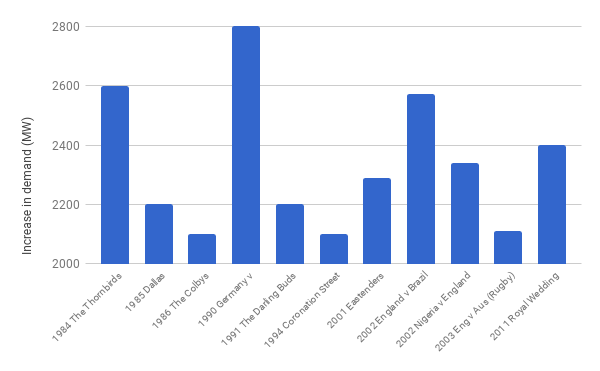
Energetic maths
When asked what is the most important invention ever made by humankind, apart from my own personal favourite of calculus (which strangely never gets many votes), one invention that always figures very highly is fire. It was fire that first allowed us to release energy in meaningful amounts. This could then be used for cooking, heating, lighting and the manufacture of new materials such as metals. Since then our whole civilisation has both relied on, and has been defined by, the need to obtain energy.
The huge advantages electrical energy has over mechanical (and most other forms of) energy is that it can be transmitted over huge distances with almost no loss, and it can be (relatively) easily controlled. This has led it to be widely adopted as the primary source of the world's energy (although about 1 billion people have no access to electrical power) and maths is vital to ensuring the lights always stay on.
Two million kettles
Producing electricity securely, safely, reliably and cheaply, has many challenges. Electricity is difficult to store in large quantities, so it usually has to be used as soon as it is generated. We also have a very low tolerance to any interruption in the electricity supply. Other challenges arise from the extreme interconnectedness of the electricity network, which means that a problem in part of the network quickly becomes a problem for the whole network. Most of the time the process of transmitting electricity proceeds smoothly. However, there are times when the users place a very large demand upon the network.
An example of this is an international football match when lots of people will not only turn on their TV sets to watch the match, but will also turn on their kettles at half time, or just after the match finishes. In the figure below we can see the demands on the UK supply by some notable football matches in some recent years. Top of the list was the famous World Cup semi final of England against West Germany, which went to penalties, but was ultimately lost by England. This match is famous for two things. Firstly, Paul Gascoigne's tears when he received a booking. And secondly for nearly shutting down the UK electricity supply network. Indeed the total change in the demand for electricity during the match was 2.8 GW, which was 11% of the total power delivered by the network and amounted to about 2 million kettles.

Data source [ http://gridline.nationalgrid.com/news/managing-euro-success/ ]
It is the mark of a good electricity supply network that this does not happen, and that the lights always stay on, regardless of the demands placed on the network! Technically this means delivering a secure electricity supply at a near constant voltage and frequency, at all points of the country, regardless of the amount of power demanded from it. Indeed the UK National Grid is very carefully controlled to make sure that the electricity supply remains stable, and the lights have (so far) always stayed on.
The modern electricity supply network relies on the invention of alternating current (AC) by Nikolas Tesla. In AC the current and the voltage vary like a wave over time, as seen below. Mathematically, these waves can be described by sine and cosine functions.
The voltage $V(t)$ and the current $I(t)$ have the form $$ V(t)=|V| \cos (\omega t + \phi_1), $$ and $$I(t)=|I| \cos (\omega t + \phi_2) $$ where $\omega$ is the frequency of 50 Hz and $\phi_1$ and $\phi_2$ are the phases of the respective waves (the phase describes how far the wave is shifted along the horizontal axis), and $|V|$ and $|I|$ are the amplitudes of the respective waves (their heights).
The reason that AC was originally adopted was that it is relatively easy to transform from a high AC voltage to a low one, and vice-versa, by using a transformer. This can be done with a small loss of energy. A high voltage can then be transmitted at a low current, meaning that the power loss on transmission (which is proportional to the square of the current) is then low. Thus AC could be transmitted over large distances at high voltage with little loss of energy. Only when it is needed to supply a domestic household is it necessary to transform the electricity down to a lower voltage.
Electricity is complex
To represent an AC voltage, electrical engineers make extensive use of complex numbers. The imaginary number $i$ satisfies the equation $$ i^2=-1 $$ which was originally thought to have no solution. Imaginary numbers, and their extension, the complex numbers, were introduced by mathematicians in the 18th century to make sense of this equation, and were originally thought to be highly abstract mathematical objects of no possible use. (You can read more about imaginary and complex numbers here.) However they lie at the heart of power engineering.
(In power engineering the convention is to use $j$ to represent an imaginary number to avoid confusion with current denoted by $i$. However in mathematics it is conventional to reverse the situation and to use $i$ for the imaginary number (as is standard in mathematics) and $j$ for current. It is pointless to argue which is better (or worse), but it is a shame that this separation exists between mathematics and engineering. Without making any judgment one way or the other as to which is best, I will use the mathematical convention here. However, I'm happy to instantly switch my allegiance when I'm working with power engineers. Indeed, not so long ago, I was one myself.)
The reason for this is Euler's famous identity $$ e^{i\theta}=\cos (\theta) + i\sin (\theta) . $$ which allows us an easy way of describing alternating current, along with it's frequency and phase. (You can read more about Euler's identity here.) An alternating voltage is the real part of the function $$ V(t)=|V| e^{i(\omega t+ \phi_1)} $$ with a similar expression for the current. A convenient way to express this is as $$ V(t)=|V| e^{i\phi_1} e^{i\omega t} $$ and we call the expression $V=|V| e^{i\phi_1}$ the complex voltage. This single complex number contains two pieces of information, namely the amplitude, and the phase, of the voltage. There is a similar expression for the complex current. Using this we can now describe how a power network works and how we can use maths to make sure that it operates well, as we shall see in the next article.
About this article

Chris Budd.
This article is adapted from one of Chris Budd's Gresham College lectures, part of a series called Mathematics and the making of the modern and future world. The lectures take place in London, are aimed at a general audience and free to attend.
Chris Budd OBE is Professor of Applied Mathematics at the University of Bath, Vice President of the Institute of Mathematics and its Applications, Chair of Mathematics for the Royal Institution, Gresham Professor of Geometry, and an honorary fellow of the British Science Association. He is particularly interested in applying mathematics to the real world and promoting the public understanding of mathematics.
He has co-written the popular mathematics book Mathematics Galore!, published by Oxford University Press, with C. Sangwin and features in the book 50 Visions of Mathematics ed. Sam Parc.
This is the first of three articles in this series – you can read more in part ii and part iii.
This content now forms part of our collaboration with the Isaac Newton Institute for Mathematical Sciences (INI) – you can find all the content from the collaboration here.
The INI is an international research centre and our neighbour here on the University of Cambridge's maths campus. It attracts leading mathematical scientists from all over the world, and is open to all. Visit www.newton.ac.uk to find out more.
